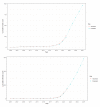Breaking Barriers: Investigating Gender Representation in the First Authors of Cardiovascular Disease and Artificial Intelligence Publications
- PMID: 37868462
- PMCID: PMC10590122
- DOI: 10.7759/cureus.45695
Breaking Barriers: Investigating Gender Representation in the First Authors of Cardiovascular Disease and Artificial Intelligence Publications
Abstract
Introduction Artificial intelligence (AI) and cardiovascular diseases have resulted in significant advancements in healthcare and medical research. This study focused on examining the gender equality ratio of first authors in "artificial intelligence and cardiovascular disease" articles from 2005 to 2022. It is critical to investigate gender representation in this dynamic subject given the growing usage of AI in cardiovascular medicine. Aims The aim of this study is to visualize the changing face of gender equality within the field of artificial intelligence (AI) and cardiovascular diseases by examining the gender distribution of the first authors' published articles from 2005 to 2022, providing important insights into disparities in gender and the potential for fostering inclusivity and diversity in the scientific community. Methodology All academic articles published from 2005 to 2022 were reviewed. The gender of the first author of each study was recorded. Since there were so few articles available for five months in 2023, they were excluded. The research was subsequently categorized based on the gender, ethnicity, and country of origin of the first authors. Results With a value of 0.54, the overall gender ratio favored male authors (275) over female authors (149). In 2022, female first authors had the most publications (59), while male first authors contributed 113 articles. Predictions for 2027 showed a significant increase in the number of publications on this topic by male authors (950) and female authors (580). A gradual increase in the number of female first authors was observed over this period, although their representation remained lower compared to male first authors. Conclusions In the first authorship, our analysis found a gender gap, with male authors predominating. Females' engagement must be encouraged if academic gender equality is to be achieved. Female researchers are empowered by creating an inclusive atmosphere through mentorship and regulatory changes. For knowledge to advance fairly, collaboration is essential.
Keywords: ai and cardiovascular disease; female; gender equality; pubmed; research.
Copyright © 2023, Sharma et al.
Conflict of interest statement
The authors have declared that no competing interests exist.
Figures
Similar articles
-
Gender Disparities in First Authorship in Publications Related to Attention Deficit Hyperkinetic Disorder (ADHD) and Artificial Intelligence (AI).Cureus. 2023 Nov 30;15(11):e49714. doi: 10.7759/cureus.49714. eCollection 2023 Nov. Cureus. 2023. PMID: 38161901 Free PMC article. Review.
-
Gender Equality Trends of First Authors in Publications of Artificial Intelligence and Thyroid.Cureus. 2023 Sep 23;15(9):e45820. doi: 10.7759/cureus.45820. eCollection 2023 Sep. Cureus. 2023. PMID: 37876392 Free PMC article. Review.
-
Female Authorship Trends Among Articles About Artificial Intelligence in North American Radiology Journals.Can Assoc Radiol J. 2023 May;74(2):264-271. doi: 10.1177/08465371221122637. Epub 2022 Sep 3. Can Assoc Radiol J. 2023. PMID: 36062579
-
Authorship gender among articles about artificial intelligence in breast imaging.Eur J Radiol. 2024 Jun;175:111428. doi: 10.1016/j.ejrad.2024.111428. Epub 2024 Mar 14. Eur J Radiol. 2024. PMID: 38492508
-
Ethnicity and gender trends of UK authors in The British Medical Journal and the Lancet over the past two decades: a comprehensive longitudinal analysis.EClinicalMedicine. 2023 Sep 7;64:102174. doi: 10.1016/j.eclinm.2023.102174. eCollection 2023 Oct. EClinicalMedicine. 2023. PMID: 37711218 Free PMC article.
Cited by
-
The gender gap in interventional cardiology research: insights from Advances in Interventional Cardiology journal (2015-2023).Postepy Kardiol Interwencyjnej. 2024 Jun;20(2):201-205. doi: 10.5114/aic.2024.140904. Epub 2024 Jun 14. Postepy Kardiol Interwencyjnej. 2024. PMID: 39022720 Free PMC article. No abstract available.
References
-
- Artificial intelligence in the diagnosis of cardiovascular disease. Zeron RM, Serrano Junior CV. Rev Assoc Med Bras (1992) 2019;65:1438–1441. - PubMed
-
- Gender parity in high impact cardiology journals. Petrechko O, Faturos AS, Pal S, et al. Curr Probl Cardiol. 2023;48:101549. - PubMed
-
- Gender differences in research productivity: a bibliometric analysis of the Italian academic system. Abramo G, D’Angelo CA, Caprasecca A. Scientometrics. 2009;79:517–539.
LinkOut - more resources
Full Text Sources
Miscellaneous



